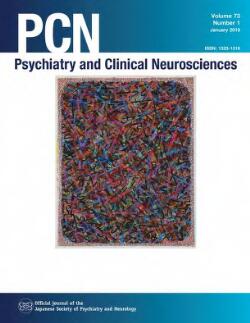血清细胞因子与从临床高危转为精神病的时间框架之间的关系
IF 5
3区 医学
Q1 CLINICAL NEUROLOGY
引用次数: 0
摘要
目的虽然许多研究都探讨了炎症标志物与精神病之间的联系,但很少有研究调查临床高危(CHR)患者最终发展为完全精神病的时间进展。为了填补这一空白,我们研究了CHR患者血清细胞因子水平与精神病转归时间(TCP)之间的相关性。在基线和1年时测量粒细胞巨噬细胞集落刺激因子(GM-CSF)、白细胞介素(IL)-1β、2、6、8、10、肿瘤坏死因子-α(TNF-α)和血管内皮生长因子(VEGF)的水平。结果中位 TCP 持续时间为 14 个月。TCP持续时间越短,TNF-α(P = 0.022)和VEGF(P = 0.016)水平越高。TCP与TNF-α水平(P = 0.006)和VEGF水平(P = 0.04)之间呈负相关。量值回归显示,TCP 与 GM-CSF 水平 0.5 量值以下、IL-10 水平 0.3 量值以下、IL-2 水平 0.25 量值以下、IL-6 水平 0.65 和 0.75 量值之间、TNF-α 水平 0.8 量值以下和 VEGF 水平 0.7 量值以下之间存在负相关。混合线性效应模型确定了IL-10和IL-2的显著时间效应,以及IL-2和TNF-α变化的显著群体效应。这凸显了在早期干预过程中考虑个体炎症特征以及针对风险特征定制预防措施的重要性。本文章由计算机程序翻译,如有差异,请以英文原文为准。
Association between serum cytokines and timeframe for conversion from clinical high‐risk to psychosis
AimAlthough many studies have explored the link between inflammatory markers and psychosis, there is a paucity of research investigating the temporal progression in individuals at clinical high‐risk (CHR) who eventually develop full psychosis. To address this gap, we investigated the correlation between serum cytokine levels and Timeframe for Conversion to Psychosis (TCP) in individuals with CHR.MethodsWe enrolled 53 individuals with CHR who completed a 5‐year follow‐up with a confirmed conversion to psychosis. Granulocyte macrophage‐colony stimulating factor (GM‐CSF), interleukin (IL)‐1β, 2, 6, 8, 10, tumor necrosis factor‐α (TNF‐α), and vascular endothelial growth factor (VEGF) levels were measured at baseline and 1‐year. Correlation and quantile regression analyses were performed.ResultsThe median TCP duration was 14 months. A significantly shorter TCP was associated with higher levels of TNF‐α (P = 0.022) and VEGF (P = 0.016). A negative correlation was observed between TCP and TNF‐α level (P = 0.006) and VEGF level (P = 0.04). Quantile regression indicated negative associations between TCP and GM‐CSF levels below the 0.5 quantile, IL‐10 levels below the 0.3 quantile, IL‐2 levels below the 0.25 quantile, IL‐6 levels between the 0.65 and 0.75 quantiles, TNF‐α levels below the 0.8 quantile, and VEGF levels below the 0.7 quantile. A mixed linear effects model identified significant time effects for IL‐10 and IL‐2, and significant group effects for changes in IL‐2 and TNF‐α.ConclusionsOur findings underscore that a more pronounced baseline inflammatory state is associated with faster progression of psychosis in individuals with CHR. This highlights the importance of considering individual inflammatory profiles during early intervention and of tailoring preventive measures for risk profiles.
求助全文
通过发布文献求助,成功后即可免费获取论文全文。
去求助
来源期刊
CiteScore
7.40
自引率
4.20%
发文量
181
审稿时长
6-12 weeks
期刊介绍:
PCN (Psychiatry and Clinical Neurosciences)
Publication Frequency:
Published 12 online issues a year by JSPN
Content Categories:
Review Articles
Regular Articles
Letters to the Editor
Peer Review Process:
All manuscripts undergo peer review by anonymous reviewers, an Editorial Board Member, and the Editor
Publication Criteria:
Manuscripts are accepted based on quality, originality, and significance to the readership
Authors must confirm that the manuscript has not been published or submitted elsewhere and has been approved by each author

 求助内容:
求助内容: 应助结果提醒方式:
应助结果提醒方式:


